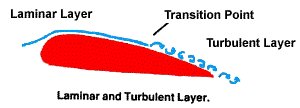boundary layer

A boundary layer is a very thin layer of air flowing over the surface of an aircraft wing, or airfoil, (as well as other surfaces of the aircraft). The molecules directly touching the surface of the wing are virtually motionless. Each layer of molecules within the boundary layer moves faster than the layer that is closer to the surface of the wing. At the top of the boundary layer, the molecules move at the same speed as the molecules outside the boundary layer. This speed is called the free-stream velocity. The actual speed at which the molecules move depends upon the shape of the wing, the viscosity, or stickiness, of the air, and its compressibility (how much it can be compacted). Further, boundary layers may be either laminar (layered), or turbulent (disordered). As the boundary layer moves toward the center of the wing, it begins to lose speed due to skin friction drag. At its transition point, the boundary layer changes from laminar, where the velocity changes uniformly as one moves away from the object's surface, to turbulent, where the velocity is characterized by unsteady (changing with time) swirling flows inside the boundary layer.
The flow outside of the boundary layer reacts to the shape of the edge of the boundary layer just as it would to the physical surface of an object. So the boundary layer gives any object an "effective" shape that is usually slightly different from the physical shape. The boundary layer may also lift off or separate from the body, creating an effective shape much different from the physical shape of the object and causing a dramatic decrease in lift and increase in drag. When this happens, the airfoil has stalled.
As well as the development of airfoil stall, the details of the flow within the boundary layer are very important for many problems in aerodynamics, including the skin friction drag of an object and the heat transfer that occurs in high-speed flight.
The theory that describes boundary layer effects was first presented by Ludwig Prandtl in the early 1900s. Prandtl was the first to realize that the forces experienced by a wing increased from the layer very near the wing's surface to the region far from the surface.


